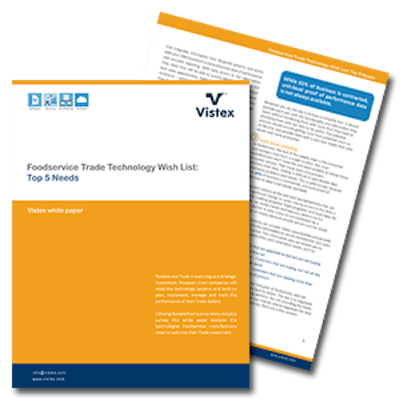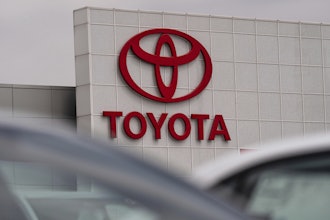
i n f o @ v i s t e x . c o m
w w w. v i s t e x . c o m
Vistex white paper
Foodservice Trade Technology Wish List:
Top 5 Needs
Foodservice Trade is maturing as a strategic
investment. However, most companies still
need the technology systems and tools to
plan, implement, manage and track the
performance of their Trade dollars.
Utilizing the data from a proprietary industry
survey, this white paper explores the
technologies Foodservice manufacturers
need to optimize their Trade investment.
In CloudOn-PremiseServicesSoftware
i n f o @ v i s t e x . c o m w w w. v i s t e x . c o m
Foodservice manufacturers have invested heavily in Trade.
Today, more than 4 out of 5 companies have dedicated trade
teams, a massive increase from the one-third who did in 2009.
Companies that have invested in Trade have unlocked success
in an industry experiencing constant change and consolidation,
and have stolen market share from competitors.
However, Trade is still maturing as a strategic investment. And
the need for systems and tools to plan, implement, manage and
track the performance of Trade dollars has become increasingly
necessary. Many manufacturers still operate without the
integrated systems needed to maximize programs, and with the
amount of money being spent on Trade, this needs to change.
Companies not already proactively addressing the urgent need
for strategically managed Trade investment programs run the
very real risk of succumbing to more astute competitors.
Manufacturers are investing 19% of their total sales into Trade,
which is their second largest expenditure aside from goods.
Also, 84% of respondents to our recent survey, “Food Service
Trade in 2015: Technology Systems are the ‘Missing Link’ to
Optimize Trade,” stated that they employ a dedicated team, but
still need the right technology to optimize their Trade programs.
Only 7% of manufacturers are fully satisfied with their current
technology systems to manage Trade, while just over half (53%)
are somewhat satisfied. They believe their systems handle the
tactical aspects, but fail to provide strategic insight like analytics
and dashboard reporting.
Manufacturers cannot maximize the return on their significant
Trade investment without the right technology to run and support
their efforts. Survey respondents shared their technology wish
lists with us, and here are their Top 5 needs:
1. Integration with other systems
2. Reporting, including dashboards.
3. Unit-level visibility.
4. Post-program analysis.
5. Self-service analytics
Integration with other systems
Manufacturers want better integration between data from
multiple sources. The disparate data you deal with on a daily
basis creates confusion for you and your Trade partners. Without
reliable information, you end up making decisions based on your
gut, instead of data-based projections. And as the foodservice
ecosystem becomes more competitive, making decisions based
on anything other than soliddata is more risky. Having all the facts
will enable you to employ a more informed decision process that
your trading partners can accept, and that will maximize success.
Too often discussions with Trade teams or supply chain partners
focus on whose numbers are right, instead of anything valuable.
Proper integration of all of your trade systems, such as ERP, CRM,
planning, financials and marketing tools, ensures all participants
have access to the right data, which enables them to focus on
solving problems.
And with a single source of truth for financial data, you can begin
to assess the success of your Trade programs. Our survey found
that only 32% of manufacturers currently perform ROI analysis,
and that the majority are hindered by lack of data, lack of data
integration or other limitations. An effective trade tool would
present all parties with the dashboards, data and functionality to
see key performance numbers in real time to enable performance
evaluation and program adjustments to maximize ROI.
This tool would help your Field Sales department perform time-
consuming tasks, such as taking orders, collections, sampling and
“ride-withs.” Asking them to access several tools to complete
these tasks is unrealistic, because it cuts into the time they could
be selling. Your field sales team would benefit from a single tool
2
Foodservice Trade Technology Wish List: Top 5 Needs
53%
Somewhat
Satisfied
40%
Not
Satisfied
7%
Very
Satisfied
Satisfaction with Current Trade
System Technology
Source: Foodservice Trade in 2015 – Technology Systems are the “Missing
Link” to Optimize Trade
1
i n f o @ v i s t e x . c o m w w w. v i s t e x . c o m
While 65% of business is contracted,
unit-level proof of performance data
is not always available.
3
that integrates information from disparate systems, and works
with your CRM to present a comprehensive view of performance
and accurate reporting. With easy access to the information
they need, they will be able to quickly identify and pursue the
best sales opportunities. Instead of following the path of least
resistance – selling to customers they already know – because
they do not have the time to acquire new prospects. Having the
right data will allow them to maximize the productivity of their
limited selling time.
Retail companies have found value in integrating third-party data
like IRI and Nielsen to their transactional and claims data, which
has provided richer insight into their customers. Foodservice has
followed suit, cultivating similar data from companies, such as
CHD-Expert and Datassentials. Properly allocating Trade spend
is like placing a bet. And having the data on which to base
your decisions gives you the best odds. If you understand the
performance of previous promotions across the market, you will
be able to use Trade funds more effectively.
Reporting and dashboards
Properly assessing the performance of your Trade programs can
be time-consuming and tedious without the right technology.
Your staff may spend hours compiling data from several sources
and entering it into a single spreadsheet or system every
quarter – or even every month. Without a clean, simple
dashboard to view the data, uncovering actionable insights
from the numbers can be challenging, and may take too long
for you to act on them.
With dashboards you will be able to quickly view and to identify
exceptions and spot trends within the data, such as which
region or product group is performing better than the rest. The
ability to quickly recognize fresh opportunities and new threats,
and course-correct before your competition, is an advantage in
the marketplace, and an edge that will enable you to increase
sales and grow your market share. Unfortunately, most tools do
not offer this functionality.
Today, most trade systems are used as tactical tools to
simply create contracts, and to process and settle claims. Few
third-party tools give you immediate visibility into
information, aggregate claims, check for double- dips and
identify operator unit locations. This functionality requires
systems to both communicate and compile data into usable
information – information that can be onerous to maintain.
Another approach is to find systems that are natively
connected, or better yet, a complete Go-to-Market solution.
Whatever you do, the key is to have a complete tool. It should
provide each user with the functionality and information they
need, without burdening them with more than they need or
providing them with too little to be useful. The selection
process should include getting input from potential users so,
in the end, you provide them with a tool that makes their jobs
easier and more productive.
Unit-level visibility
In foodservice, the end of the supply chain is the consumer
purchasing a meal from a single location. But most
manufacturers don’t have the unit-level visibility to follow these
consumer actions. Their trade tools only process
summary-level data, making it difficult to spot double-dips,
compliance problems and trends. This is unfortunate, because
while 65% of business is contracted, unit-level proof of
performance data is not always available.
Consumers’ actions at the unit level are bellwethers that can
signal significant change to come. Having access to this data is
critical for crafting proactive Trade programs Unit-level data, for
example, can reveal trends and help you determine if a
seasonal decline in sales is due to encroachment by a
competitor or simply because schools are on summer break.
Unit-level visibility can uncover these opportunities and provide
field sales with the information to secure incremental case sales
in a mature market. This information also can enable you to
track new opportunities and compliance issues, such as:
■ Customers that are approved to buy but are not buying
everything they can
■ White space – Customers that are buying, but not all the
products they could
■ Double-dips – Customers that are claiming more than
once for a case of product
Unit-level visibility is the holy grail of foodservice, and not
surprisingly, is therefore hard to obtain. The key is to negotiate
upfront with your trading partners. You are providing the funds
for all trade programs, so you may be able to negotiate the data
you need from them. However, there are a few caveats:
Foodservice Trade Technology Wish List: Top 5 Needs
3
2
i n f o @ v i s t e x . c o m w w w. v i s t e x . c o m
Trade spend on average accounts for
nearly 20% of a manufacturers’ sales,
and is the second highest expense
behind the cost of goods.
4
■ Do not ask for unit-level data if you cannot utilize it.
You do not want to frustrate your partners who have to
collect and send the data. And you do not want to slow
your overall process with unneeded information.
■ It can be better to simply take what you can get from
partners, knowing that you can improve the data over
time, especially if you show them the value of the
information.
■ Consider utilizing a data aggregation tool to provide you
with a clean data stream from various partners.
Post-program analysis
Trade spend on average accounts for nearly 20% of a
manufacturers’ sales, and is the second highest expense behind
the cost of goods. Every manufacturer tries to turn this
considerable expense into a strategic investment, but that
requires the ability to identify which programs are working and
which ones are not. Expanding successful programs and
eliminating fruitless ones is particularly important in
foodservice, where programs run on an annual basis, which
amplifies their value or detriment. Can you afford to continue
to invest dollars without knowing ROI?
Without the ability to perform post-promotional analysis, you
likely are running the same stale and stagnant promotions year
after year. This gives those competitors who do analyze their
promos the opportunity to boost program performance,
maximize their Trade investment and cut into your market
share. They do this by engaging in a collaborative, fact-based
process with their trading partners that drives win-win
negotiations and, ultimately, increased market penetration.
Gaining post-program visibility is vital, but it is easier said than
done. The most effective way is to negotiate program goals with
clients up-front, to create a contract that clearly states
expectations for both parties. Once this is done, you need a
system to collect program data for analytics. Ideally, the
technology should be able to input claims, automatically
identify any components that are incorrect (wrong customer
name, wrong product, wrong price, invalid contract), allow you
to process what is approved, then investigate any exceptions
down to the unit level.
With that done, you will have all of the necessary data in-hand.
But do you have the systems in place to analyze the data, the
staff to conduct the analysis and the courage to discuss the
outcomes (both good and bad) and act upon the results? You
may discover you are maximizing the impact of your programs
or, more likely, you will find that you are far from hitting the
mark. Whatever you learn, it will help you make your programs
better in the long run.
Self-service analytics
Foodservice manufacturers are searching for a way to reduce
the amount of data requests each department (claim teams,
sales, marketing, finance, production) receives from different
parts of their organization. Often, each department keeps
different data in different formats, making it difficult to
compare, collect and use the information. Thus, responding
to these requests becomes a monthly burden, and is rarely
compiled into something useful in time to provide benefit.
But with a tool that enables self-service analytics, every group
within your company will have access to the data, and have the
opportunity to understand how they impact programs, pricing
and products.
As we have discussed, access to the right information is vital
to business success. Not only will it help you determine if your
programs are successful, it will help you spot trends early so
you can quickly resolve any issues or anomalies you discover.
However, analytics is not simply numbers. It is numbers that
tell a story and provide actionable insights to improve your
business. The story leads to sales. For example, your field sales
staff can use up-to-the-minute information on shipments, trade
claims and payments to know exactly what clients need, and
enabling them to move more product. They would also gain a
distributor-level view of the contracted vs. street breakdown
which would drive better negotiations on programs and prices.
In foodservice, there is truth to the adage, “information is
power.”
Foodservice Trade Technology Wish List: Top 5 Needs
5
4
w w w. v i s t e x . c o m
Solution
■Program Strategy
■Analytics
■ Implementation
■Post-Production Support
■Training
■Global Payments
■Program Administration
Services
i n f o @ v i s t e x . c o m
■Contracts
■Pricing
■Rebates
■Benefits
■Trade & Channel
■Rights & Royalties
■Performance Management
■Payment
Make More. Keep More. Grow Smarter.
In CloudOn-PremiseServicesSoftware
About Vistex
Vistex provides enterprise solutions that manage pricing, incentive, rebate, royalty and channel programs to enhance
business performance while reducing labor and infrastructure costs. The industry-optimized Go-to-Market Suite®
provides end-to-end solutions for design, management and administration of the complete spectrum of programs. With
an unparalleled offering of software and services, enterprises are empowered with unprecedented visibility into program
performance, gaining deeper insights to better enable fact-based decisions that drive revenue, control cost, minimize
leakage, and streamline processes.
Vistex®, Go-to-Market Suite®,ViZi®, and other Vistex, Inc. graphics, logos, and service names are trademarks, registered trademarks or trade
dress of Vistex, Inc. in the United States and/or other countries. No part of this publication may be reproduced or transmitted in any form or for
any purpose without the expressed written permission of Vistex, Inc. The information contained herein may be changed without prior notice.
© Copyright 2015 Vistex Inc. All rights reserved.






















